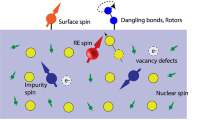Abstract
A recent theoretical model, based on tunneling states, for the heat capacity and thermal conductivity of amorphous solids below 1 K is extended to include thermal expansion. The calculated Grüneisen constant γ is sensitive to the details of the tunneling states, but the model provides an explanation for the large negative values of γ observed in vitreous silica below 4 K.
Similar content being viewed by others
References
A. J. Leadbetter,Phys. Chem. Classes 9, 1 (1968).
G. K. White,Cryogenics 4, 2 (1964).
P. W. Anderson, B. I. Halperin, and C. M. Varma,Phil. Mag. 25, 1 (1972).
W. A. Phillips,J. Low Temp. Phys. 7, 351 (1972).
R. C. Zeller and R. O. Pohl,Phys. Rev. B4, 2029 (1971).
G. K. White and J. A. Birch,Phys. Chem. Glasses 6, 85 (1965).
M. Papoular,J. Phys. C 5, 1943 (1972).
S. Hunklinger, private communication.
Author information
Authors and Affiliations
Additional information
Work supported by the Research Corporation and by the Electric Research Council.
Rights and permissions
About this article
Cite this article
Phillips, W.A. Tunneling states and the low-temperature thermal expansion of glasses. J Low Temp Phys 11, 757–763 (1973). https://doi.org/10.1007/BF00654457
Received:
Issue Date:
DOI: https://doi.org/10.1007/BF00654457




